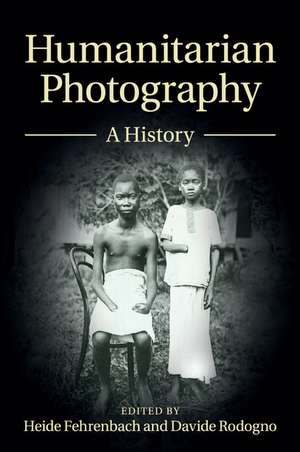Humanitarian Photography: A History: Human Rights in History
Editat de Heide Fehrenbach, Davide Rodognoen Limba Engleză Paperback – 14 sep 2016
| Toate formatele și edițiile | Preț | Express |
|---|---|---|
| Paperback (1) | 320.75 lei 6-8 săpt. | |
| Cambridge University Press – 14 sep 2016 | 320.75 lei 6-8 săpt. | |
| Hardback (1) | 759.99 lei 6-8 săpt. | |
| Cambridge University Press – 22 feb 2015 | 759.99 lei 6-8 săpt. |
Din seria Human Rights in History
-
 Preț: 232.73 lei
Preț: 232.73 lei -
 Preț: 286.30 lei
Preț: 286.30 lei -
 Preț: 310.51 lei
Preț: 310.51 lei -
 Preț: 255.09 lei
Preț: 255.09 lei -
 Preț: 230.10 lei
Preț: 230.10 lei -
 Preț: 277.57 lei
Preț: 277.57 lei -
 Preț: 184.88 lei
Preț: 184.88 lei -
 Preț: 318.22 lei
Preț: 318.22 lei -
 Preț: 312.46 lei
Preț: 312.46 lei -
 Preț: 232.45 lei
Preț: 232.45 lei -
 Preț: 276.61 lei
Preț: 276.61 lei -
 Preț: 232.24 lei
Preț: 232.24 lei -
 Preț: 230.61 lei
Preț: 230.61 lei -
 Preț: 281.30 lei
Preț: 281.30 lei - 8%
 Preț: 564.43 lei
Preț: 564.43 lei - 9%
 Preț: 593.67 lei
Preț: 593.67 lei -
 Preț: 194.09 lei
Preț: 194.09 lei -
 Preț: 230.51 lei
Preț: 230.51 lei -
 Preț: 227.33 lei
Preț: 227.33 lei - 14%
 Preț: 895.53 lei
Preț: 895.53 lei - 11%
 Preț: 597.10 lei
Preț: 597.10 lei -
 Preț: 216.39 lei
Preț: 216.39 lei -
 Preț: 280.74 lei
Preț: 280.74 lei -
 Preț: 288.42 lei
Preț: 288.42 lei - 11%
 Preț: 600.84 lei
Preț: 600.84 lei - 14%
 Preț: 757.85 lei
Preț: 757.85 lei -
 Preț: 264.74 lei
Preț: 264.74 lei -
 Preț: 233.22 lei
Preț: 233.22 lei -
 Preț: 242.08 lei
Preț: 242.08 lei -
 Preț: 327.51 lei
Preț: 327.51 lei -
 Preț: 272.75 lei
Preț: 272.75 lei - 11%
 Preț: 537.58 lei
Preț: 537.58 lei -
 Preț: 288.25 lei
Preț: 288.25 lei - 14%
 Preț: 708.38 lei
Preț: 708.38 lei -
 Preț: 225.97 lei
Preț: 225.97 lei
Preț: 320.75 lei
Nou
Puncte Express: 481
Preț estimativ în valută:
61.38€ • 65.63$ • 51.17£
61.38€ • 65.63$ • 51.17£
Carte tipărită la comandă
Livrare economică 17 aprilie-01 mai
Preluare comenzi: 021 569.72.76
Specificații
ISBN-13: 9781107639713
ISBN-10: 1107639719
Pagini: 366
Ilustrații: 60 b/w illus.
Dimensiuni: 152 x 230 x 20 mm
Greutate: 0.49 kg
Editura: Cambridge University Press
Colecția Cambridge University Press
Seria Human Rights in History
Locul publicării:New York, United States
ISBN-10: 1107639719
Pagini: 366
Ilustrații: 60 b/w illus.
Dimensiuni: 152 x 230 x 20 mm
Greutate: 0.49 kg
Editura: Cambridge University Press
Colecția Cambridge University Press
Seria Human Rights in History
Locul publicării:New York, United States
Cuprins
Introduction. The morality of sight: humanitarian photography in history Heide Fehrenbach and Davide Rogodno; 1. Picturing pain: evangelicals and the politics of pictorial humanitarianism in an imperial age Heather Curtis; 2. Framing atrocity: photography and humanitarianism Christina Twomey; 3. The limits of exposure: atrocity photographs in the Congo reform campaign Kevin Grant; 4. Photography, visual culture, and the Armenian genocide Peter Balakian; 5. Developing the humanitarian image in late nineteenth- and early twentieth-century China Caroline Reeves; 6. Photography, cinema, and the quest for influence: the international committee of the Red Cross in the wake of the first world war Francesca Piana; 7. Children and other civilians: photography and the politics of humanitarian image-making Heide Fehrenbach; 8. Sights of benevolence: UNRRA's recipients portrayed Silvia Salvatici; 9. All the world loves a picture: the World Health Organization's visual politics, 1948–73 Thomas David and Davide Rodogno; 10. 'A' as in Auschwitz, 'B' as in Biafra: the Nigerian civil war, visual narratives of genocide, and the fragmented universalization of the Holocaust Lasse Heerten; 11. Finding the right image: British development NGOs and the regulation of imagery Henrietta Lidchi; 12. Dilemmas of ethical practice in the production of contemporary humanitarian photography Sanna Nissinen.
Recenzii
'This beautifully edited volume shows how absolutely central visual culture must be to our understanding of modern humanitarianism. Whether on atrocity, famine, or genocide, these essays explore photography's enduring power to shape the moral and political dynamics of international crises.' J. P. Daughton, Stanford University
'This collection of essays offers a most inspiring conceptualization of the use of photography for humanitarian purposes - for all historians in the burgeoning field of humanitarianism and related subjects as well as for those working in media studies. It enriches contemporary debates on humanitarian aid and humanitarian intervention, which have been and are still being strongly shaped by the visual representation of suffering and relief.' Johannes Paulmann, Director, Leibniz Institute of European History, Mainz
'The history of humanitarian aid and of humanitarianism is closely associated with the development of modern media, yet few have demonstrated critically the role of a technology or aesthetic approach like this tightly edited volume under the stewardship of Heide Fehrenbach and Davide Rodogno. This book is a pioneering and essential read for anyone interested in the growth and globalization of humanitarian consciousness. The images this book contains remain as disturbing and as shocking as they were intended to be decades ago, but the text sets them back in their context and tells their hidden stories. The book is essential reading for all historians of the twentieth century and today's humanitarians who now have to represent sufferings without losing their own soul.' Bertrand Taithe, Humanitarian and Conflict Response Institute, University of Manchester
'The most important contribution of this volume is the development of a new historically useful concept with ramifications for the history of photography and, more broadly, for the visual history of the contemporary world … By the end of the volume, readers will have gained a thorough historical overview of a distinct photographic practice, with case studies from Africa, Asia, the Middle East, Europe, and the United States.' Ana Maria Mauad, Society for U.S. Intellectual History, Book Reviews (https://s-usih.org/)
'This collection of essays offers a most inspiring conceptualization of the use of photography for humanitarian purposes - for all historians in the burgeoning field of humanitarianism and related subjects as well as for those working in media studies. It enriches contemporary debates on humanitarian aid and humanitarian intervention, which have been and are still being strongly shaped by the visual representation of suffering and relief.' Johannes Paulmann, Director, Leibniz Institute of European History, Mainz
'The history of humanitarian aid and of humanitarianism is closely associated with the development of modern media, yet few have demonstrated critically the role of a technology or aesthetic approach like this tightly edited volume under the stewardship of Heide Fehrenbach and Davide Rodogno. This book is a pioneering and essential read for anyone interested in the growth and globalization of humanitarian consciousness. The images this book contains remain as disturbing and as shocking as they were intended to be decades ago, but the text sets them back in their context and tells their hidden stories. The book is essential reading for all historians of the twentieth century and today's humanitarians who now have to represent sufferings without losing their own soul.' Bertrand Taithe, Humanitarian and Conflict Response Institute, University of Manchester
'The most important contribution of this volume is the development of a new historically useful concept with ramifications for the history of photography and, more broadly, for the visual history of the contemporary world … By the end of the volume, readers will have gained a thorough historical overview of a distinct photographic practice, with case studies from Africa, Asia, the Middle East, Europe, and the United States.' Ana Maria Mauad, Society for U.S. Intellectual History, Book Reviews (https://s-usih.org/)
Descriere
This book investigates the historical evolution of 'humanitarian photography' - the mobilization of photography in the service of humanitarian initiatives across state boundaries.











